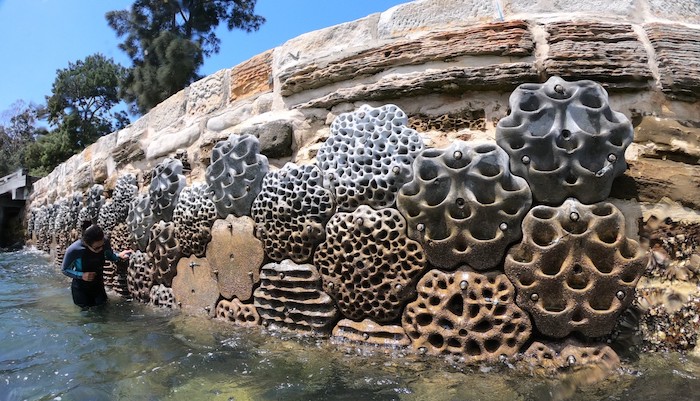
A team of scientists is designing special panels that can be attached to marine infrastructure to make it more attractive for colonisation by sea life. The Living Seawalls project, led by coastal ecologists Associate Professor Melanie Bishop and Katherine Dafforn of Macquarie University in Sydney, is a finalist in the Earthshot environment prizes, to be awarded later in October by HRH Prince William, the Duke of Cambridge.
According to a study that Bishop and Dafforn undertook together with a team of international collaborators, in 2018, marine structures had a global footprint of at least 32,000 square kilometres. Estimates suggest that over the next decade, the area of seascape modified for power and aquaculture infrastructure, cables and tunnels worldwide will increase by at least another 50 per cent.
‘There is an ongoing construction boom in our seas – from seawalls, pilings, pontoons and marinas to offshore wind turbines, aquaculture developments and mining rigs,’ Bishop told the university’s online magazine, The Lighthouse. ‘This is hugely detrimental to marine ecology, often in the harbours, estuaries and coastal foreshores that are the nurseries and food sources for most oceanic life.’
In order to make the marine infrastructure more accommodating for sea life, the Living Seawalls team has drawn on decades of marine research to develop a series of marine panels, or tiles, that can be attached in modules to provide habitat for marine plants and animals. So far, the team has designed ten different habitat surfaces, which mimic natural shoreline features.Working with industrial designer Alex Goad and Reef Design Lab, they use 3D printing to create moulds in which they cast the concrete panels.
There are now more than 1,000 of the roughly 60-centimetre-diameter panels installed globally – mostly around Australia but also as far away as Gibraltar and Wales. Their modular design allows them to be tailored to each site.
Ongoing monitoring of the panels has found that they host more than 100 different species of invertebrate and seaweed, and are used by more than 30 species of fish. ‘We found that after two years, our panels already supported at least a third more species on them than the seawalls that had been there for decades,’ Bishop said. ‘The panels had a similar mix and quantity of life to the natural rocky reefs nearby, which are biodiversity hotspots.’
According to Bishop, the success of the Living Seawalls is partly down to the team’s multi-disciplinary approach, which sits at the intersection of marine ecology, architecture, design and engineering. ‘By using good science and designing our marine infrastructure with nature in mind, Living Seawalls has enormous potential to increase the ecological and social value of coastal structures worldwide,’ she says.



